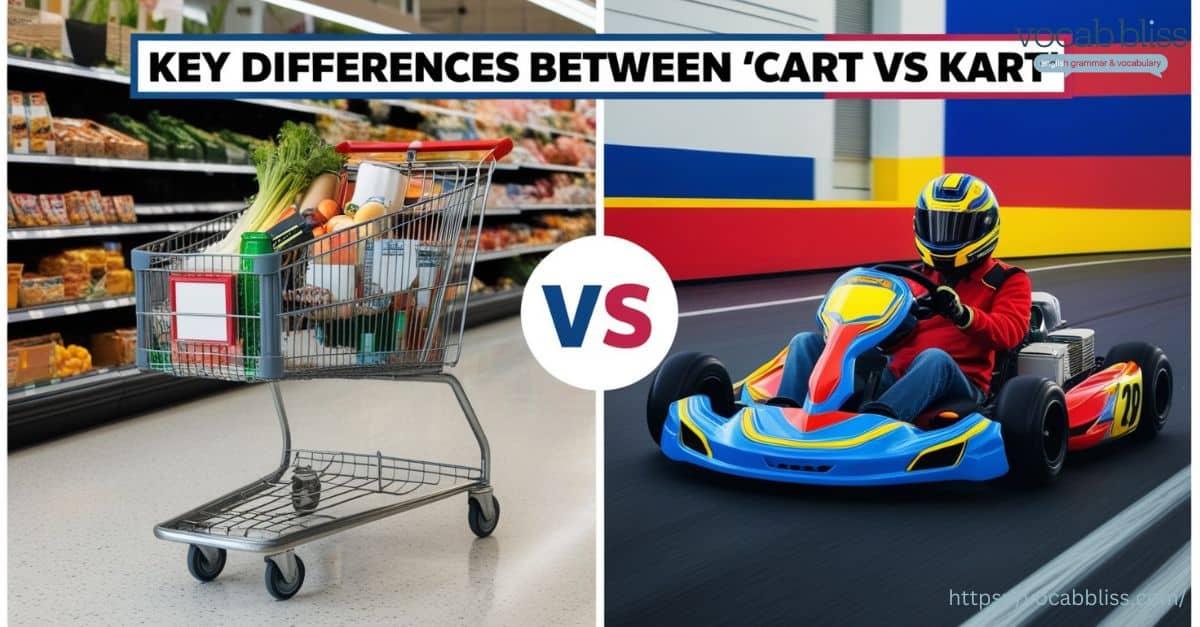Language can often be tricky, especially when two words sound nearly identical but carry different meanings. One such pair is “Kart vs Cart”. Both words are associated with vehicles, but their contexts, histories, and uses differ significantly. In this guide, we’ll explore the distinctions, and delve into their origins. Additionally, we’ll provide clear examples to help you use the right spelling every time..
Quick Summary
When it comes to Kart vs Cart, the distinction lies in their meanings, uses, and contexts. A cart refers to a utility vehicle or device used for transporting goods, such as a shopping cart or an animal-drawn cart. On the other hand, a kart is a small, motorized vehicle primarily associated with recreational activities like go-kart racing. While “cart” is practical and widely used in daily life, “kart” represents fun and leisure, especially in motorsports. Understanding these differences ensures you use the right term whether discussing transportation, shopping, or thrilling racing experiences.
Continue reading: Sueing or Suing? Choose the Right Term
Understanding “Cart” and Its Uses

Definition of “Cart”
The term “cart” refers to a vehicle or device, typically with wheels, used to transport goods, people, or materials. Its design can range from simple and manually operated to complex and motorized. While the core function of a cart remains the same—carrying items—it is versatile enough to adapt to different industries and contexts.
In historical contexts, carts were primarily animal-drawn, serving as essential tools for agriculture and trade. However, today, the word encompasses everything from grocery store shopping aids to recreational vehicles like golf carts. Ultimately, the defining feature of a cart is its functionality and practicality, which, in turn, is aimed at making the transportation of items easier.
As a result, carts are designed to streamline the process and therefore enhance efficiency in various settings.
Examples of “Cart” in Everyday Language:
- “I need a shopping cart for my groceries.”
- “The farmer used a wooden cart to carry hay.”
Common Uses of “Cart”
The word “cart” is deeply integrated into modern life, appearing in various settings. For example, below are some of its most common applications:
- Shopping Carts
Shopping carts are metal or plastic frames with wheels found in retail stores. They are designed for customers to load and transport goods while shopping. Fun fact: The shopping cart was invented in 1937 by Sylvan Goldman to make shopping more convenient. - Hand Carts
These are smaller, often two-wheeled devices designed for moving heavy loads manually. For example, dollies and trolleys are commonly used in warehouses or for moving heavy furniture. Additionally, these tools help reduce physical strain and improve efficiency during tasks that require transporting bulky items. - Animal-Drawn Carts
Historically, carts were pulled by animals like horses, oxen, or donkeys. These carts were used for transporting goods or passengers, particularly in rural or pre-industrialized societies. - Golf Carts
Small motorized vehicles, often electric, are used on golf courses to transport players and their equipment. In addition, they represent a modern adaptation of the cart concept, blending functionality with convenience. As a result, these vehicles offer an efficient and practical solution for golfers, enhancing the overall experience. - Online Shopping Carts
In the digital world, the term “cart” has taken on a virtual meaning. An online shopping cart is a tool that allows customers to select and save items they intend to purchase later.
Cart Examples in Popular Culture:
- “Put it in the cart” is a phrase familiar to online shoppers.
- Classic depictions of farmers often include horse-drawn carts laden with produce.
Table: Types of Carts and Their Uses
| Type of Cart | Primary Use | Example Scenario |
|---|---|---|
| Shopping Cart | Transporting goods in stores | Grocery shopping |
| Hand Cart | Moving heavy loads | Warehouse equipment |
| Animal-Drawn Cart | Agricultural or trade purposes | Transporting crops to market |
| Golf Cart | Transporting players on golf courses | Moving between holes on a course |
| Online Shopping Cart | Virtual storage for online purchases | E-commerce platforms like Amazon |
Anecdote:
Many historians attribute the success of early trade routes to the efficiency of carts. As a result, by reducing the physical burden of carrying goods, carts became indispensable tools for merchants and farmers alike.
Furthermore, they enabled faster transportation of goods, contributing to the expansion of trade networks. In addition, carts were crucial in improving agricultural practices, making them an essential part of daily life.Even today, their relevance persists, albeit in more modern forms.
What is a “Kart”?

Definition of “Kart”
A “kart” refers to a small, lightweight, and often motorized vehicle designed primarily for recreation or competitive racing. Unlike “carts,” which are utility-oriented, karts are built for speed, maneuverability, and fun.
The most common example is the go-kart, a compact four-wheeled vehicle used in kart racing, a popular motorsport enjoyed by both amateurs and professionals. Go-karts are typically powered by gasoline or electric motors and are constructed with simplicity to ensure they are accessible and easy to handle. While the term “kart” is most closely associated with go-karts, it can also encompass other recreational vehicles in similar niches.
Characteristics of a Kart:
- Design: Small, low to the ground, and lightweight.
- Engine: Powered by gasoline or electric motors.
- Purpose: Recreation, competition, and introductory motorsport training.
Applications of “Kart”
The versatility of karts makes them an integral part of both the motorsport and recreation industries. In addition, karts offer a wide range of uses across various settings. Here are the primary applications of karts:
Kart Racing
Kart racing is the most recognized use of karts. In fact, this high-adrenaline sport serves as a stepping stone for many professional race car drivers, including Formula 1 legends like Lewis Hamilton and Michael Schumacher. Moreover, kart racing is divided into various categories based on the kart type, age group, and competition level. As a result, it offers opportunities for all skill levels, from beginners to experienced racers.
Key features of kart racing:
- Track Type: Short, twisty circuits with sharp turns.
- Speed: High-performance karts can reach speeds of 100 mph or more.
- Accessibility: A popular entry-level motorsport due to its relatively low cost compared to other forms of racing.
Recreational Karts
Outside competitive racing, recreational karts are, in fact, a common attraction at amusement parks and entertainment centers. In these settings, these karts prioritize safety and fun over speed, which makes them suitable for all ages. Moreover, they provide an exciting experience without the need for intense racing skills. As a result, people of all backgrounds can enjoy them comfortably.
Examples of recreational karting:
- Indoor karting facilities for birthday parties or team-building events.
- Outdoor tracks for family fun or casual weekend outings.
Niche in Motorsports
Karts have carved out a unique niche in motorsports, acting as training vehicles for young drivers aspiring to enter professional racing leagues. In addition, their simple design and responsiveness make them ideal for developing driving skills, reflexes, and race strategy.
Moreover, karts provide an excellent platform for honing essential skills in a controlled environment, which is crucial for those looking to advance to higher levels of competition.
| Type of Kart | Primary Use | Examples |
|---|---|---|
| Go-Karts | Recreational racing | Indoor karting tracks, family amusement parks |
| Racing Karts | Competitive motorsport | Professional karting leagues, F1 training |
| Off-Road Karts | Adventure driving | Dune buggies, dirt track racing |
Fun Fact:
Karting gained global recognition in the 1950s when Art Ingels, a California engineer, built the first go-kart using a surplus lawnmower engine.
Key Differences Between “Cart vs Kart”

Meaning
The distinction between “cart vs kart” lies primarily in their definitions and purposes.
- A cart is a utility-focused vehicle or device designed for transporting goods, people, or materials. Its primary function revolves around practicality, whether in a grocery store, a warehouse, or an agricultural setting.
- Example: “The farmer loaded the hay onto the cart.”
- A kart, on the other hand, is a small, often motorized vehicle associated with leisure or competitive racing. The emphasis is on speed, fun, and maneuverability rather than transport.
- Example: “The kids enjoyed racing their go-karts at the track.”
This key difference highlights how “cart” represents practicality and utility, while “kart” embodies excitement and recreation.
Usage in Everyday Language kart vs cart
The words “kart or cart” are used in distinct contexts, reflecting their unique meanings. Here’s how they commonly appear:
Examples of “Cart” in Language:
- Shopping Cart: “Don’t forget to grab a cart before heading into the store.”
- Animal-Drawn Cart: “The horse pulled the wooden cart through the village.”
- Digital Cart: “I’ve added the items to my online cart for checkout.”
Examples of “Kart” in Language:
- Go-Kart Racing: “The go-kart track was crowded with enthusiastic racers.”
- Motorsport Training: “Karting is a great way to introduce young drivers to racing.”
While “cart” is more prevalent in practical and everyday settings, “kart” finds its niche in recreational or sporting conversations.
Physical Characteristics kart vs cart
The structural and functional differences between carts or karts are significant and reflect their unique purposes.
Characteristics of a Cart:
- Design: Simple, sturdy, and functional, often open-topped for easy loading.
- Material: Commonly made from metal, wood, or plastic.
- Operation: May be manually operated, animal-drawn, or motorized.
- Use Case: Designed for moving goods, heavy items, or passengers.
Examples:
- A hand cart used by warehouse workers.
- A shopping cart with four wheels for stability.
Characteristics of a Kart:
- Design: Compact and low to the ground, with a focus on speed and agility.
- Material: Lightweight materials like aluminum or fiberglass.
- Operation: Powered by engines (gasoline or electric).
- Use Case: Primarily for recreational or competitive racing.
Examples:
- A go-kart used on a racetrack.
- Off-road karts built for rugged terrain.
| Feature | Cart | Kart |
|---|---|---|
| Purpose | Transport goods or people | Leisure and competitive racing |
| Material | Metal, wood, or plastic | Lightweight alloys, fiberglass |
| Design | Open, utility-focused | Compact, aerodynamic |
| Operation | Manual, animal-drawn, or motorized | Motorized with gasoline or electric |
| Examples | Shopping cart, hand cart, animal-drawn cart | Go-kart, off-road kart, racing kart |
Historical Origins of “Cart vs Kart”

The History of “Cart”
The term “cart” dates back to medieval times and was primarily used to describe animal-drawn vehicles. These carts were essential for agriculture, trade, and transportation. Over time, the term expanded to include modern shopping carts and other wheeled devices.
The History of “Kart”
“Kart” is a relatively modern term. Initially, it originated in the mid-20th century to describe motorized racing vehicles. Furthermore, its spelling was influenced by the word “go-kart,” a small vehicle used for recreational racing.
The Role of “Go-Cart” in Bridging the Terms
Interestingly, people used the term “go-cart” to describe small hand carts or early motorized buggies before “kart” became popular. Over time, however, the evolution of this term into “kart” highlights how language adapts to new technologies. As a result, we can see how the meaning shifted alongside advancements in transportation.
Examples of “Cart vs Kart” in Context
Real-Life Examples of “Cart”
The term “cart” deeply embeds itself in practical and everyday scenarios, often tying to transportation and utility. For example, here are some illustrations of its use:
In Shopping:
- “She wheeled the grocery cart down the aisle, carefully selecting fresh produce.”
- Scenario: A customer using a shopping cart in a supermarket to carry items to the checkout counter.
- Online Usage: “I forgot to add the item to my cart before completing the purchase.”
In Farming and Agriculture:
- “The farmer loaded the wooden cart with bales of hay to feed the livestock.”
- Scenario: An animal-drawn cart used in rural settings to transport tools, crops, or feed.
In Household Chores:
- “He used a utility cart to move the heavy flowerpots across the yard.”
- Scenario: A small wheeled cart for carrying tools and supplies during home improvement tasks.
Historical and Artistic Context:
- “The art piece depicted a traditional horse-drawn cart rolling down a cobbled street.”
- Scenario: Depictions of carts in historical settings, showcasing their importance in earlier transportation methods.
Real-Life Examples of “Kart”
People most often associate the word “kart” with fun and competitive activities, particularly in the realm of motorsports.Below are some examples highlighting its use:

In Racing:
- “The go-kart zoomed around the tight corners of the track, leaving a trail of excitement in its wake.”
- Scenario: A young racer competing in a local go-kart championship.
Recreational Activities:
- “The amusement park featured a family-friendly kart track where kids could drive safely.”
- Scenario: Visitors enjoying leisurely go-karting sessions in an indoor or outdoor setting.
As a Gateway to Professional Motorsports:
- “Many Formula 1 drivers, like Lewis Hamilton, started their careers in kart racing.”
- Scenario: Aspiring racers honing their skills on competitive karting circuits.
Pop Culture and Gaming:
- “Mario Kart is a timeless video game that brings friends together for racing fun.”
- Scenario: Video game enthusiasts enjoying multiplayer sessions of Mario Kart, a playful take on kart racing.
Comparing Contexts
| Scenario | Cart Example | Kart Example |
|---|---|---|
| Shopping | “She filled her grocery cart.” | (Not applicable) |
| Transport | “The goods were loaded into the cart.” | (Not applicable) |
| Recreation | (Not applicable) | “The go-kart race was thrilling.” |
| Motorsport | (Not applicable) | “Professional drivers often start with karts.” |
| Digital Context | “Items were added to the online cart.” | (Not applicable) |
Fun Fact:
The transition from “cart or kart” in language demonstrates how slight variations in spelling can indicate a shift from practicality to entertainment. Whether you’re at a racetrack or a supermarket, the right term ensures clarity and context.
Practical Tips for Choosing the Correct Term
Audience and Context Considerations
When deciding between “cart vs kart”, consider your audience and context. Use “cart” when referring to tools or vehicles for transportation. Opt for “kart” when discussing recreation or motorsports.
Avoiding Common Mistakes
- Remember: Carts are for carrying; karts are for racing.
- Double-check spelling in written communication, especially when writing for diverse audiences.
Conclusion
The differences between “cart vs kart” go beyond just spelling. Their meanings, uses, and origins reflect distinct aspects of our daily lives and recreational activities. In addition, by understanding these nuances, you can confidently choose the right term every time. Moreover, this knowledge helps ensure clarity in both practical and fun contexts. Whether you’re writing about a shopping trip or a day at the racetrack, knowing the difference ensures clear and effective communication.
Which term do you use more often? Feel free to share your thoughts or experiences with kart vs cart in the comments below! Additionally, we’d love to hear any insights you may have about their usage.
Explore further:
- Appendices or Appendixes? Clarifying Usage
- Busses or Buses: Clarifying the Plural Form of “Bus”
- Lier or Liar: Picking the Right Word
- skillset or skill set, Skill-Set,: Which is Right?

Jorge Phillips is an experienced blogger who writes for Vocab Bliss, sharing his passion for the English language. With a knack for simplifying complex grammar rules and a focus on commonly confused words, Jorge helps readers navigate the nuances of English with ease. His insights aim to make learning engaging and practical.







